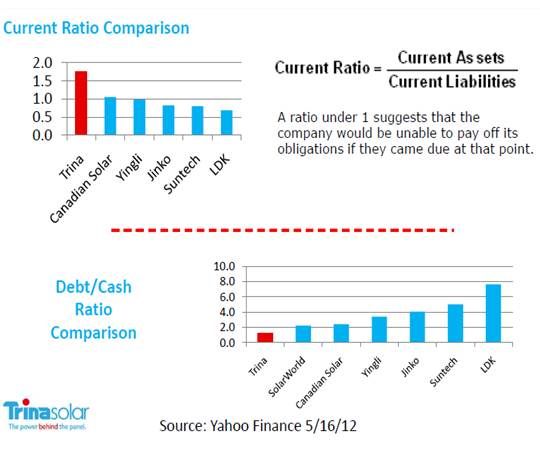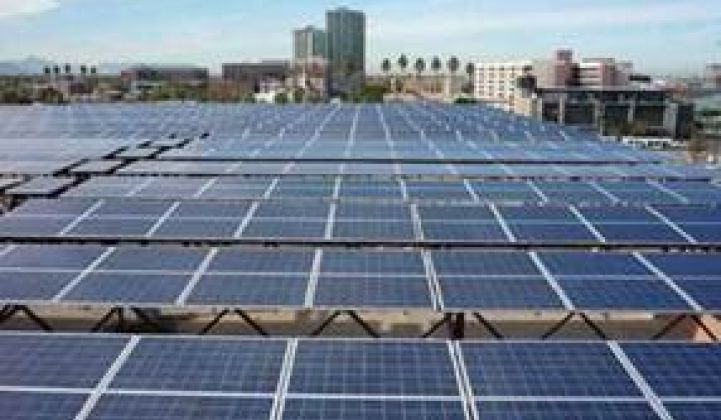According to the U.S. Department of Commerce (DOC), Trina Solar has been guilty of using Chinese government subsidies to win a big portion of the U.S. solar panel market. The DOC imposed a 31.14 percent tariff on the company.
But Trina awarded itself a Triple Crown for 2011 because of numbers it achieved that belied the popular image a Chinese solar manufacturer, and, even compared to other Chinese solar makers that had similar advantages and saw similar tariffs imposed on them, made it a leader in financial viability, field performance and sustainability practices.
Financial viability makes many things possible. Price Waterhouse Cooper subsidiary PRTM Management Consulting ranked Trina first in its Sustainable Growth Index.
“The metrics we were ranked on,” explained Trina Solar Americas Director of Marketing Mike Grunow, “were balance sheet strength and cost structure.” There is a fundamental reason, he said, for those good numbers.

“Over the past three or four years,” he explained, “solar manufacturers have taken on enormous amounts of debt and used that debt to experiment with business models and investigate a ton of new technologies. Very early on, we had the foresight to choose a technology path that was capital efficient and thus had the ability to not be distracted significantly by experimental business models downstream and potential new technologies that didn’t pan out.”
Trina has, instead, been “very conservative and saved,” Grunow said. “During that time, we raised significantly less debt than some of our competitors [and] built up our balance sheet to support our product.” That conservative strategy, he said, “is coming home to roost” in the PRTM rankings.
Grunow said Trina’s multi-crystalline silicon panel and its Honey technology manufacturing platform were what led to its success. “Right now, we hold the world record for the most efficient multi-crystalline silicon panel produced.”
Confirmed by TUV Rheinland, Trina’s Honey platform-manufactured, standard size Honey Ultra module (1650 mm x 992 mm) reached 284.7 watts peak power output in May 2012.
The Honey platform, Grunow said, is “four or five different incremental manufacturing improvements bundled together to provide the best tradeoff between performance and cost. You get the lion’s share of high-efficiency performance at a much smaller incremental cost to the consumer.”
_540_449_80.jpg)
Trina’s number one ranking by watchdog Silicon Valley Toxics Coalition (SVTC) for its industry-standard sustainability practices did not “just happen,” Grunow said. Sustainability is a priority set by CEO Jifan Gao as his way of answering the doubters Gao faced daily when he began in the business as a rooftop solar system seller/installer.
“Long before he created our company, he was selling and installing solar systems. Again and again he would hear questions, especially in the early '90s." It was a time when the economics of solar were far more dubious, Grunow said, “so buyers wanted to know about efficiency and environmental impacts.”
The company now produces an annual report “solely focused on our company’s environmental practices, use of energy, and use of water. These are core metrics and there are teams of people working every day in our company to find ways to improve them.”
It pays off, Grunow said. Trina’s products are being used by “channel partners like SolarCity and SunEdison [because] more and more, we see end-users looking to the Silicon Valley Toxics Coalition report as a way to understand the environmental attributes of the products [and] Trina panels are being specifically requested by clients who want to protect their image and don’t want to install dirty panels.”
Hundreds of practices at Trina’s factories contribute to the SVTC ranking, but a key, Grunow said, “is what we call our solar manufacturing campus approach.” The Trina campus in Changzhou, China, an hour-and-a-half outside of Shanghai, has “all our suppliers” on or near “the primary assembly facility.” This eliminates “a large portion of the inbound logistics costs of the raw materials and the inbound energy required,” according to Grunow.

The efficiency of Trina’s multicrystalline panels was verified by a field performance test published by the California Energy Commission in which panels’ claimed capacity factors were compared to obtained capacity factors.
Trina’s number-one ranking, Grunow said, was due to the way it rates its panels. To achieve a high rating, he said, “some manufacturers cut corners. One common way is to label a panel, say, 200 watts, plus or minus three percent.” The result is a panel that may be rated at 200 watts but only deliver 195 watts in the field. “Trina,” Grunow said, uses “plus three percent, minus zero” so its panels will not under-deliver.
In field performance testing done by third parties, Grunow said, panels of plus three percent or minus three percent from other manufacturers may turn up. “There are two or three studies that show Trina’s panels consistently perform in the field better than almost everybody else’s,” he said. “The proof is in the output number.”
There are other lists on which Trina’s numbers put it high at this crucial juncture in solar industry evolution. “Right now, everybody is wondering who are the few solar companies that are going to be around in five years,” Grunow said, “and Trina is consistently at the top of the lists.”
But with the module tariff, not to mention the anticipated slowing of the industry’s big California and New Jersey markets and the gap left by the expiration of the 1603 tax grant, Trina could find it challenging to stay high up on those lists.



